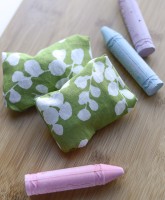Posted by in Group Games | Comments Off on Homonym Beanbag Toss
Homonym Beanbag Toss

Homonym Beanbag Toss
As second graders get quicker and more accurate with the written word, you can expect them to spend plenty of time discovering and mastering homonyms. These are tricky little words that tend to confound early readers because they sound the same but are spelled differently. Hear and here, for example, are homonyms; so are their, they’re and there, and to, too, and two. Kids run into homonyms early on in their reading days, and they can be quite a challenge. First graders, for example, crave simple, predictable rules of phonics, and homonyms have a way of blasting them. But now, second graders are ready to have some fun exploring these classic quirks of our language.
Homonyms are often taught with worksheets in second grade, but with a little extra ingenuity, they can also lend themselves to marvelous physical games. Here’s one we recommend:
What You Need:
Stretch of blank pavement
3-5 beanbags
Chalk
2 or more kids
What You Do:
Use your chalk to write several classic homonym words on a stretch of pavement. Place each word in a box of three different sizes—some boxes will be huge; others, medium sized; others, more difficult, will be small. You and your child can explore lots of different words, but you will want to be sure that by the end of second grade, your child will know too, to, and two; here and hear; see and sea; and their, they’re, and there. So start with those today!
Now measure a few yards back from the words and their boxes—you can adjust the distance, depending on your child’s aim—and take out the beanbags. Have kids take turns throwing; the object of the toss should be to cover all the boxes for one homonym. Let’s say, for example, that a child chooses to, two, and too. The aim should be to hit those three boxes accurately, and then tally the score. A small box counts three points; a medium one, two; and a large box counts one. Any complete match of two or three words forming a homonym gives a Grand Sweep Score of Ten!
Do pay attention to how close or far your child is standing. If the game is too hard, move the throw line forward; if it’s too easy, move it back. But do keep playing, and as your kids learn one set of homonyms, don’t hesitate to launch another. Just rinse off the chalk and start again!
What’s going on? In second grade, kids start to spend more time on desk work, and less in what learning experts call “kinesthetic,” or full-body learning. But “kinesthetic” work is still a powerful way to learn, and kids of all ages can thrive on it. So go ahead and toss away!
